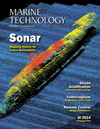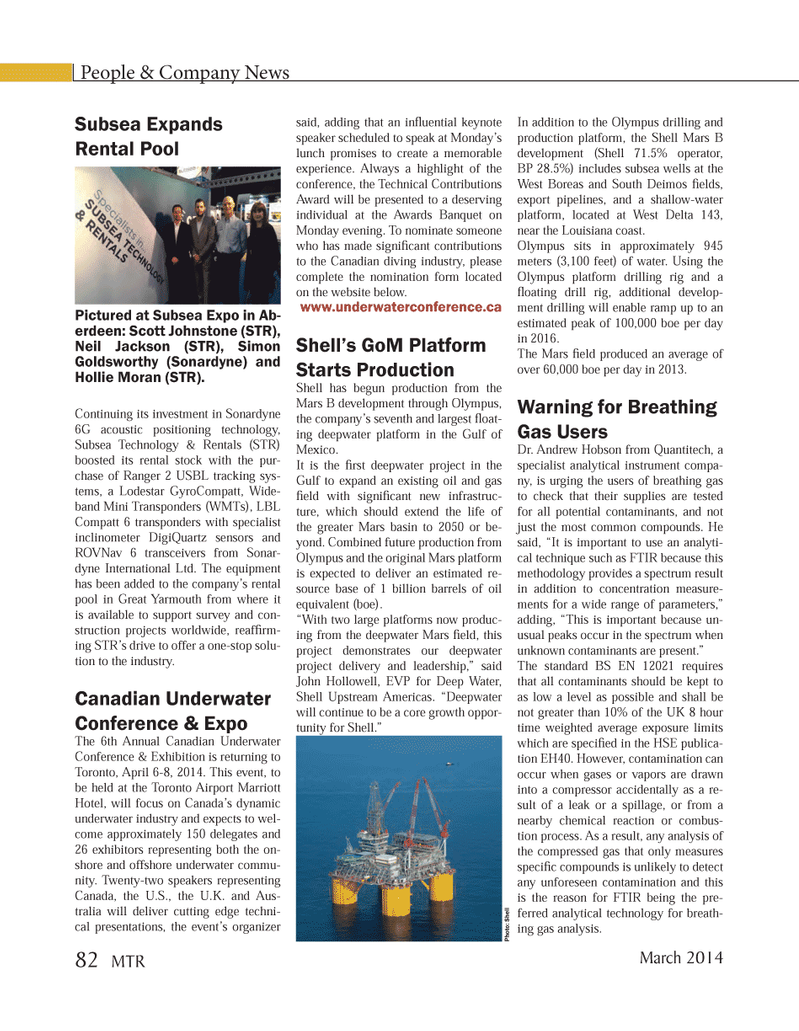
Page 82: of Marine Technology Magazine (March 2014)
Instrumentation: Measurement, Process & Analysis
Read this page in Pdf, Flash or Html5 edition of March 2014 Marine Technology Magazine
People & Company News Subsea Expands Rental Pool Continuing its investment in Sonardyne 6G acoustic positioning technology, Subsea Technology & Rentals (STR) boosted its rental stock with the pur- chase of Ranger 2 USBL tracking sys-tems, a Lodestar GyroCompatt, Wide- band Mini Transponders (WMTs), LBL Compatt 6 transponders with specialist inclinometer DigiQuartz sensors and ROVNav 6 transceivers from Sonar- dyne International Ltd. The equipment has been added to the company?s rental pool in Great Yarmouth from where it is available to support survey and con- struction projects worldwide, reaf rm-ing STR?s drive to offer a one-stop solu- tion to the industry. Canadian Underwater Conference & Expo The 6th Annual Canadian Underwater Conference & Exhibition is returning to Toronto, April 6-8, 2014. This event, to be held at the Toronto Airport Marriott Hotel, will focus on Canada?s dynamic underwater industry and expects to wel- come approximately 150 delegates and 26 exhibitors representing both the on- shore and offshore underwater commu- nity. Twenty-two speakers representing Canada, the U.S., the U.K. and Aus- tralia will deliver cutting edge techni- cal presentations, the event?s organizer said, adding that an in uential keynote speaker scheduled to speak at Monday?s lunch promises to create a memorable experience. Always a highlight of the conference, the Technical Contributions Award will be presented to a deserving individual at the Awards Banquet on Monday evening. To nominate someone who has made signi cant contributions to the Canadian diving industry, please complete the nomination form located on the website below. www.underwaterconference.ca Shell?s GoM Platform Starts Production Shell has begun production from the Mars B development through Olympus, the company?s seventh and largest oat-ing deepwater platform in the Gulf of Mexico. It is the rst deepwater project in the Gulf to expand an existing oil and gas eld with signi cant new infrastruc- ture, which should extend the life of the greater Mars basin to 2050 or be-yond. Combined future production from Olympus and the original Mars platform is expected to deliver an estimated re- source base of 1 billion barrels of oil equivalent (boe). ?With two large platforms now produc- ing from the deepwater Mars eld, this project demonstrates our deepwater project delivery and leadership,? said John Hollowell, EVP for Deep Water, Shell Upstream Americas. ?Deepwater will continue to be a core growth oppor- tunity for Shell.? In addition to the Olympus drilling and production platform, the Shell Mars B development (Shell 71.5% operator, BP 28.5%) includes subsea wells at the West Boreas and South Deimos elds, export pipelines, and a shallow-water platform, located at West Delta 143, near the Louisiana coast. Olympus sits in approximately 945 meters (3,100 feet) of water. Using the Olympus platform drilling rig and a oating drill rig, additional develop- ment drilling will enable ramp up to an estimated peak of 100,000 boe per day in 2016. The Mars eld produced an average of over 60,000 boe per day in 2013. Warning for Breathing Gas Users Dr. Andrew Hobson from Quantitech, a specialist analytical instrument compa-ny, is urging the users of breathing gas to check that their supplies are tested for all potential contaminants, and not just the most common compounds. He said, ?It is important to use an analyti-cal technique such as FTIR because this methodology provides a spectrum result in addition to concentration measure-ments for a wide range of parameters,? adding, ?This is important because un-usual peaks occur in the spectrum when unknown contaminants are present.? The standard BS EN 12021 requires that all contaminants should be kept to as low a level as possible and shall be not greater than 10% of the UK 8 hour time weighted average exposure limits which are speci ed in the HSE publica- tion EH40. However, contamination can occur when gases or vapors are drawn into a compressor accidentally as a re-sult of a leak or a spillage, or from a nearby chemical reaction or combus- tion process. As a result, any analysis of the compressed gas that only measures speci c compounds is unlikely to detect any unforeseen contamination and this is the reason for FTIR being the pre-ferred analytical technology for breath-ing gas analysis.Pictured at Subsea Expo in Ab-erdeen: Scott Johnstone (STR), Neil Jackson (STR), Simon Goldsworthy (Sonardyne) and Hollie Moran (STR).Photo: ShellMarch 2014 82 MTRMTR #2 (82-96).indd 82MTR #2 (82-96).indd 822/22/2014 2:16:47 PM2/22/2014 2:16:47 PM

 81
81

 83
83
